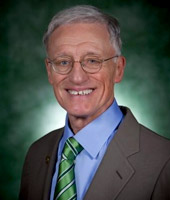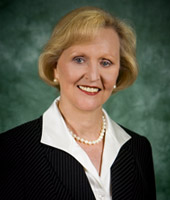History of the Presidency and the University
Presidential Leadership
Since it was established in 1946, Binghamton University has benefited from the vision and direction of five outstanding presidents.
C. Peter Magrath (2010-2011, 1972-1974)

President C. Peter Magrath has led Binghamton University in two very different eras. When he was named president in 1972, Binghamton was a growing campus of some 6,000 students. During his first tenure at Binghamton, he worked to develop the University's emerging graduate programs and to strengthen campus-community connections. President Magrath left Binghamton in 1974 to become president at the University of Minnesota, where he served until 1984.
The Binghamton University Magrath returned to in 2010 was much larger, with nearly 15,000 students, significantly greater research, academic and residential facilities, and expanded research and graduate programs. Magrath's goals for the University were to increase enrollment, to enhance its reputation for academic excellence and to build on and establish new partnerships between the University and community and state organizations. He was especially effective in establishing academic and research partnerships in Asia and developing new ties with SUNY's Upstate Medical University.
In addition to serving as president at Binghamton and the University of Minnesota, Magrath also served as interim president at West Virginia University (2008-2010), as president of the University of Missouri system (1985-1991) and as president and CEO of the National Association of State Universities and Land Grant Colleges (NASULGC), now the Association of Pubic and Land-grant Universities (APLU). Magrath also taught at Brown University and served in several administrative positions at the University of Nebraska. He received his bachelor's degree in political science from the University of New Hampshire and a PhD from Cornell University.
Lois B. DeFleur (1991-2010)

The first female president at Binghamton University, Lois B. DeFleur arrived at Binghamton in 1991 with four main objectives: to develop the University's research capacities, to provide new academic and co-curricular opportunities for undergraduates, to internationalize the campus and expand faculty and student diversity, and to develop private support while extending campus outreach into the community.
During her time at Binghamton, she oversaw the addition of dozens of new graduate programs, with the result that by the time she left, every school and college offered doctoral degrees. In addition, the University added two new colleges — the Graduate School of Education and the College of Community and Public Affairs. In 2007, DeFleur received the Harold R. McGraw Jr. Prize in Education for her work in promoting campus internationalization.
There was a significant expansion and beautification of the campus during her tenure and she oversaw the transition of the University's intercollegiate athletics teams from NCAA Division III to Division I. DeFleur also guided the campus through its first-ever comprehensive gifts campaign, Believe in Binghamton, which raised $43.7 million for student scholarships, facilities enhancement and faculty support, laying the foundation for the University's second campaign, Bold. Brilliant.Binghamton, with a goal of raising $95 million.
DeFleur received her doctoral degree in sociology from the University of Illinois and her bachelor's degree from Blackburn College. She held administrative positions at the University of Missouri and Washington State University, and in the 1970s played an key role in helping integrate women into the United States Air Force Academy.
Clifford D. Clark (1975-1990)
In memoriam
When Clifford Clark was named president of Binghamton University, his chief objective was to continue the progress that had been made toward establishing a comprehensive graduate program. A statewide fiscal crisis stemming from the near bankruptcy of New York City in 1975 significantly reduced opportunities for campus expansion and limited the development of new educational and research initiatives. Rather than implementing broad growth in all areas, Clark's administration focused on developing graduate education in selective programs.
The University's Mission Statement of 1977 expressed this goal succinctly: Binghamton would "develop a limited number of high quality doctoral and organized research programs," while offering a "liberal arts program of the highest quality to a carefully selected student body." As fiscal stability returned in the 1980s, Clark recommitted the University to expanding its research and graduate programs, especially in the sciences, and strengthened the University's professional schools. During his tenure, Binghamton University added the Thomas J. Watson College of Engineering and Applied Science, saw the restructuring of several programs into the School of Education and Human Development and witnessed a major expansion of the Decker School of Nursing.
Clark worked to enhance relations with the community by establishing the Harpur Forum (now Binghamton University Forum) which brought community leaders together with campus faculty and staff to discuss current issues. He was a strong supporter of campus diversity, working for the statewide development of the Educational Opportunity Program (EOP), and provided support for the Office of Services for Students with Disabilities.
Under Clark's leadership, the percentage of minority students on campus grew from just over 5 percent in 1975 to more than 16 percent in 1980. This legacy continues through the Clifford D. Clark Graduate Fellowship Program for Diversity, established in 1990, which provides merit-based fellowships for graduate students who demonstrate exceptional scholarly talent and who contribute to the diversity of the student body. To date, more than 600 graduate students have benefited from this program.
A noted economist, Clark earned his bachelor's degree from the University of Kansas and his master's and PhD from the University of Chicago. Prior to earning his degrees, he served with the 42nd Infantry in World War II, helping to liberate the Nazi concentration camp at Dachau in 1945. Following the war, he served with the Quadrapartite Government of Occupation working to resolve the status of displaced individuals, and later was employed by the Central Intelligence Agency, where he worked as an analyst.
In addition to his administrative and faculty roles at Binghamton, Clark also served as the dean of the School of Business at the University of Kansas, taught and served as an administrator at New York University and taught at North Carolina State University.
From 2002-2005, Clark was a visiting professor of economics at the University of Illinois, Urbana/Champaign, and from 2006 until his death, he was a visiting professor at Wayne State University in Detroit, Michigan, where he taught a highly acclaimed course in international development economics to a select group of graduate and undergraduate students from diverse backgrounds.
G. Bruce Dearing (1965-1971)
President G. Bruce Dearing, as the successor to Glenn Bartle, guided the campus through the transition from a small, selective liberal arts college into one of the four research universities of the State University of New York. Thus, Dearing's tenure was marked by significant growth -- in enrollment, in academic programs and in campus facilities.
In 1965, Harpur College enrollment stood at 2,150 students, but within five years enrollment nearly tripled to more than 6,100. During this time, both the the School of Nursing (now the Decker College of Nursing and Health Sciences) and the School of Management were founded, as was the School of Advanced Technology (which would later become the Thomas J. Watson College of Engineering and Applied Science). It was also during this period that Binghamton University acquired its first computers -- IBM punch-card machines used primarily for faculty research and administrative functions.
Dearing also oversaw two curricular "experiments" involving scheduling and grading systems -- an unpopular trimester plan and an A-B-C-no grade scheme that was very well-liked by students, though less so by faculty. The trimester system was ended after only four years, while the grading system remained in place longer, not ending until 1977.
Dearing's time as president coincided with the social and political upheaval of the late 1960s and early '70s, and the University witnessed many student protests raging from complaints about grading policies and campus curfews to military recruiting and the Vietnam War. Following the deaths of four students at Kent State University in Ohio, Dearing led students, faculty and staff on an anti-war march from the Vestal campus to downtown Binghamton. He resigned as president in 1971 to become vice president for academic programs for the State University of New York.
As a self-described "literary man with a technocratic bent," Dearing received his bachelor's degree from Swarthmore and his master's and PhD in English from the University of Iowa. He later returned as a faculty member to Swarthmore, where he earned a second master's degree in psychology. Dearing also taught at the University of Minnesota, the University of Massachusetts and the University of Delaware, where he served as dean of arts and sciences before coming to Binghamton. He later joined the faculty at Upstate Medical University, where he served briefly as interim dean. Dearing served as the chair of the Middle States Commission on Higher Education from 1980 to 1984. He died in 1985.
Glenn G. Bartle (1946-1965)
Glenn G. Bartle was the founding president of what is now Binghamton University. He came to the region in 1945 to serve as dean of the newly established Triple Cities College (TCC), in Endicott, N.Y. An extension campus of Syracuse University, TCC was meant to meet the educational needs of GIs returning to the area following their service in World War II. Bartle had a more expansive vision -- his goal was to make the new college a "public Swarthmore" – a quality liberal arts college with excellent faculty and very high academic standards. His leadership was crucial in guiding the University through its formative years and remains the basis for the University's continuing excellence in undergraduate education.
As the institution's first leader, Bartle was a "hands-on" administrator who left his mark on all aspects of the college's development. He was instrumental in establishing the general education curriculum that would become the heart of undergraduate education at the campus and, in 1950, Bartle oversaw the separation of Triple Cities College from Syracuse University and its integration as Harpur College in the State University of New York system.
Throughout the 1950s, Bartle worked to secure a permanent home for the campus, eventually settling on the University's current site in Vestal. He admired the location for its rolling hills and broad fields, and working with other administrators and the highly-regarded architectural firm of Moore and Hutchins, helped design the overall campus plan.
In the latter part of the 1950s, as the State University of New York moved to establish itself as a major public university system, Bartle worked with Harpur College faculty to develop both educational and infrastructural support for graduate education and research programs. This planning and advocacy paid off when, in 1960, SUNY released its Master Plan identifying Harpur College as one of the four University Centers that would eventually offer both master's and doctoral degrees. By 1965, when Bartle announced his retirement, Harpur College (soon to be known as the State University of New York at Binghamton) offered its first PhD-level courses, in English and history, though it would fall on Bartle's successors to fully implement graduate programs at the University.
An Indiana native, Bartle earned his master's degree and doctorate in geology from Indiana University. He taught and served as dean at the University of Kansas City, now part of the University of Missouri system. During World War II he was posted at Swarthmore College, training Navy mid-shipmen. Following his retirement from Harpur College in 1965, Bartle worked for the United States Agency for International Development (AID) helping to establish the curricula for the American University System, which operated nine overseas campuses. He died in 1977 and was buried at Vestal Hills Cemetery overlooking the Binghamton University campus.
Mailing Address:
Binghamton University
Office of the President
P.O. Box 6000
Binghamton, NY 13902-6000